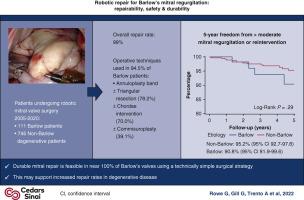The Journal of Thoracic and Cardiovascular Surgery ( IF 6 ) Pub Date : 2022-06-01 , DOI: 10.1016/j.jtcvs.2022.05.033 Georgina Rowe 1 , George Gill 1 , Alfredo Trento 1 , Dominic Emerson 1 , Amy Roach 1 , Achille Peiris 1 , Wen Cheng 1 , Natalia Egorova 2 , Joanna Chikwe 1

|
Objective
In Barlow disease, increased repair complexity drives decreased repair rates. We evaluated outcomes of a simplified approach to robotic mitral repair in Barlow disease.
Methods
A prospective institutional registry with vital-statistics, statewide admissions and echocardiographic follow-up was used to identify 924 consecutive patients undergoing robotic surgery for degenerative mitral regurgitation (MR) between 2005 and 2020, including 12% (n = 111) with Barlow disease. Freedom from >moderate (>2+) MR was analyzed with death as a competing risk and predictors of failure were analyzed using multivariable Cox regression. Median follow-up was 5.5 years (range, 0-15 years).
Results
Patients with Barlow disease were younger (median, age 59 years; interquartile range [IQR], 51-67 vs 62; IQR, 54-70 years, P = .05) than patients without Barlow disease. Replacements were performed in 0.9% (n = 1) of patients with Barlow disease and 0.8% (n = 6) of patients without Barlow disease (P = 1). Repairs comprised simple leaflet resection and annuloplasty band in 73.9% (n = 546) of non-Barlow valves versus 12.7% (n = 14) of patients with Barlow disease who required neochordae (53.6%, n = 59), chordal transfer (20%, n = 22), and commissural sutures (37.3%, n = 41), with longer cardiopulmonary bypass time (median 133; IQR, 117-149 minutes vs 119; IQR, 106-142 minutes, P < .01). Survival free from greater than moderate MR at 5 years was 92.0% (95% confidence interval [CI], 80.2%-98.1%) in patients with Barlow disease versus 96.0% (95% CI, 93.3%-98.0%) in patients without Barlow disease (P = .40). Predictors of late failure included Barlow disease (hazard ratio, 3.9; 95% CI, 1.7-9.0) and non-Barlow isolated anterior leaflet prolapse (hazard ratio, 5.6; 95% CI, 2.3-13.4).
Conclusions
Barlow disease may be reliably and safely repaired with acceptable long-term durability by experienced robotic mitral surgery programs.
中文翻译:

巴洛二尖瓣反流的机器人修复:可修复性、安全性和耐用性
客观的
在巴洛病中,修复复杂性的增加导致修复率降低。我们评估了巴洛病机器人二尖瓣修复的简化方法的结果。
方法
一项包含生命统计数据、全州入院情况和超声心动图随访的前瞻性机构登记系统用于识别2005 年至 2020 年间连续 924 名因退行性二尖瓣反流 (MR) 接受机器人手术的患者,其中 12% (n = 111) 患有巴洛病。将死亡作为竞争风险来分析摆脱 > 中度 (>2+) MR 的情况,并使用多变量Cox 回归分析失败的预测因素。中位随访时间为 5.5 年(范围:0-15 年)。
结果
患有 Barlow 病的患者比没有 Barlow 病的患者更年轻(中位年龄 59 岁;四分位距 [IQR],51-67 比 62;IQR,54-70 岁,P = 0.05)。0.9% (n = 1) 的巴洛病患者和 0.8% (n = 6) 的非巴洛病患者进行了置换术 ( P = 1)。修复包括简单的瓣叶切除和瓣环成形术,其中 73.9%(n = 546)的非巴洛瓣膜患者采用了简单的瓣叶切除和瓣环成形术,而巴洛病患者中则有 12.7%(n = 14)需要新脊索(53.6%,n = 59)、腱索移植(20 %,n = 22)和连合缝合(37.3%,n = 41),心肺转流时间较长(中位数 133;IQR,117-149 分钟 vs 119;IQR,106-142 分钟, P < .01)。患有 Barlow 病的患者 5 年无大于中度 MR 的生存率为 92.0%(95% 置信区间 [CI],80.2%-98.1%),而没有患有 Barlow 病的患者则为 96.0%(95% CI,93.3%-98.0%)。巴洛病 ( P = .40)。晚期失败的预测因子包括 Barlow 病(风险比,3.9;95% CI,1.7-9.0)和非 Barlow 孤立性前叶脱垂(风险比,5.6;95% CI,2.3-13.4)。
结论
通过经验丰富的机器人二尖瓣手术程序,可以可靠、安全地修复巴洛病,并具有可接受的长期耐久性。



























 京公网安备 11010802027423号
京公网安备 11010802027423号